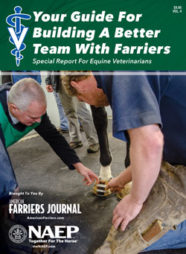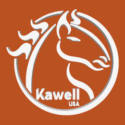Farrier Takeaways
- Answer client questions in a positive tone vs. with indifference or negativity.
- Be careful to not badmouth other farriers when responding to client questions about the previous practitioner.
- A customer who feels defensive or less valued is difficult to recover in a farrier-client relationship.
Reading the American Association of Professional Farriers Credentialing Study Guide, I came across a quote that impacted me.
“No one cares about how much you know, until they know how much you care,” wrote Mike Hayward.
I have more than 20 years of customer service experience through various professions and means: on phones, internet/email and retail face-to-face. In addition to these other customer service experiences, I have operated my farrier business for 16 years.
When anyone is genuinely fascinated by their vocation — especially when it tends toward a craft or art — they become focused on advancing, honing and perfecting the knowledge and skill set involved. It’s worth keeping in mind, though, that however passionate you are about what you do, without customers, you have a vocation in a vacuum — effectively a hobby.
Avoid the Negative, Spin the Positive
Through my experiences, I understand that customers never want to hear the phrase “I can’t,” “That won’t work,” or “I don’t have it.” Customers don’t want negative responses. Certainly, the circumstances may dictate you can’t, won’t or don’t have it. The issue may prove that the customer’s request can’t be done. However, it’s possible to avoid the negative and master the art of using words in a positive manner that makes customers feel valued or better about the situation.
Some examples are “I feel like this would work better,” or “That product is no longer available, but I will make sure that we find one that will work for you.” Remember that customers want to hear what you can do or what you’re willing to do, not what you can’t or won’t do. In the customer’s mind, all they hear is “I’m not useful to you” or “I don’t matter.” As a customer, my personal pet peeve is hearing, “I don’t know.” What I — and our customers — want to hear is “I will look into that and get back to you right away.” And for heaven’s sake, make sure you get back to them.
It doesn’t matter what stage you are as a farrier, your clients must understand that you are attentive. Whether using face-to-face conversation, telephone, email or other communication, a client who asks a question or voices a concern first needs to feel like I genuinely care about their issue and what they have to say. If a customer feels I am indifferent, they immediately lose faith in my answer to the question or my ability to resolve the problem. Who wants to feel unimportant? If I were to approach the matter with an attitude of indifference, or worse be aggressive in my responses, it will likely put the customer immediately on the defensive. Once a customer becomes defensive or closed-minded, it is much harder to bring them back into a positive window and continue a successful relationship.
Nobody knows what that farrier had to work with to begin with …
Set the Stage for Success
In 2019 I polled farriers to find the five most frequent questions that they receive from new clients. I purposely kept this focused on new clients, as I find existing clients tend to ask more complex or nuanced questions. With each question, I offer my customer service advice on keeping the response positive.
1. Did my last farrier do a bad job? Generally this client wants to confirm with family, friends or barn mates that the new farrier backs me up. Do not engage! It is not useful or necessary to agree with or create negativity about the previous farrier. We have all heard that “nobody knows what that farrier had to work with to begin with.” Furthermore, you wouldn’t want bad things said about you, so don’t do it to your peers.
Instead, politely explain to the customer that you were not there at the exact time the work was being done, so you can’t adequately judge the quality of the work, but you can make sure you provide your best effort to do the right thing for the horse in this current moment to help it stay sound or become more sound.
2. Does that hurt him/her? This is a moment when I gauge my clients. Sometimes I provide a short and simple answer, “It’s a nearly painless process, not unlike cutting your own nails.”
When the situation involves a lame or geriatric horse, I may explain that it could cause some mild and temporary discomfort standing on three legs while being trimmed. The joints may be sore or perhaps if there are hoof problems, the weight-bearing hooves may be uncomfortable. I keep this response positive in some way, “Its joints may not like holding the horse up on three legs, but I will be quick, give the horse frequent breaks and it will stretch back out quickly once I am finished.”
3. How much do you charge? This is likely the most common question of all, and frequently the first one asked. For a newer farrier, it can be difficult because the urge to under-price your rates to gain the new client is strong. Resist this urge. You are worth your fees, and the confidence in your answer will give the client confidence that you are the right person for the job. If they are simply price hunting and you aren’t the cheapest one called, that’s acceptable. You don’t want that kind of client because they will leave you as soon as you raise your prices or as soon as someone cheaper comes to town.
4. How long have you been a farrier? An easy question for the veterans to answer, but for those new to the trade, stating a short time frame may cause a lack of confidence in yourself or the potential client. Clients want to feel like you are capable of keeping their horse sound. In this case, consider an answer like “I have been working independently for 1 year, but worked for 5 years as an apprentice under a highly accomplished farrier after I completed my schooling. I continue to take frequent opportunities to apprentice under various experienced farriers. In addition, I embrace ongoing education opportunities any time they arise.”
Prioritize continuing education; take each and every opportunity you can to further your knowledge and experience. Reach out to other farriers and ride with them. Even if you’re more experienced, there is always something to be learned from another farrier. I learn something new nearly weekly and occasionally learn what not to do.
5. Does your back hurt? The only right answer is the honest answer. For me, I explain to them that it only occasionally hurts if I work on tough horses or after a long workday. I am proactive in explaining that each morning, I perform back strengthening exercises and I practice good working posture during my work activities.







